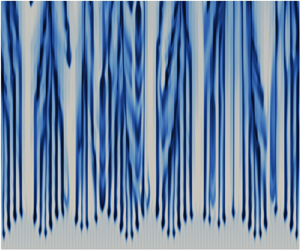Article contents
A pore-scale resolved direct numerical simulation study for scaling analysis of the solutal convection in porous media
Published online by Cambridge University Press: 25 November 2024
Abstract

Understanding the solutal convection is a crucial step towards accurate prediction of CO $_2$ sequestration in deep saline aquifers. In this study, pore-scale resolved direct numerical simulations (DNS) are performed to analyse the scaling laws of the solutal convection in porous media. The porous media studied are composed of uniformly distributed square or circular elements. The Rayleigh numbers in the range
$_2$ sequestration in deep saline aquifers. In this study, pore-scale resolved direct numerical simulations (DNS) are performed to analyse the scaling laws of the solutal convection in porous media. The porous media studied are composed of uniformly distributed square or circular elements. The Rayleigh numbers in the range  $426 \le Ra \le 80\,000$, the Darcy numbers in the range
$426 \le Ra \le 80\,000$, the Darcy numbers in the range  $1.7\times 10^{-8} \le Da \le 8.8\times 10^{-6}$ and the Schmidt numbers in the range
$1.7\times 10^{-8} \le Da \le 8.8\times 10^{-6}$ and the Schmidt numbers in the range  $250 \le Sc \le 10^4$ are considered in the DNS. The main time, length and velocity scales affecting the solutal convection are classified as the diffusive scales (
$250 \le Sc \le 10^4$ are considered in the DNS. The main time, length and velocity scales affecting the solutal convection are classified as the diffusive scales ( $t_I$,
$t_I$,  $l_I$ and
$l_I$ and  $u_I$), the convective scales (
$u_I$), the convective scales ( $t_{II}$,
$t_{II}$,  $l_{II}$ and
$l_{II}$ and  $u_{II}$) and the shut-down scales (
$u_{II}$) and the shut-down scales ( $t_{III}$,
$t_{III}$,  $l_{III}$ and
$l_{III}$ and  $u_{III}$). These scales determine the pore-scale Rayleigh number
$u_{III}$). These scales determine the pore-scale Rayleigh number  $Ra_K$ and the Rayleigh number
$Ra_K$ and the Rayleigh number  $Ra$. Based on the DNS results, the scaling laws for the transient dissolution flux are proposed in the different regimes of convection. It is found that the onset time of convection (
$Ra$. Based on the DNS results, the scaling laws for the transient dissolution flux are proposed in the different regimes of convection. It is found that the onset time of convection ( $t_{oc}$) and the period of the flux-growth regime (
$t_{oc}$) and the period of the flux-growth regime ( $\Delta t_{fg}$) vary linearly with the convective time scale
$\Delta t_{fg}$) vary linearly with the convective time scale  $t_{II}$. The merging of the original plumes and the re-initiation of the new plumes start in the same period, resulting in the merging re-initiation regime. Horizontal dispersion plays an important role in plume merging. The dissolution flux
$t_{II}$. The merging of the original plumes and the re-initiation of the new plumes start in the same period, resulting in the merging re-initiation regime. Horizontal dispersion plays an important role in plume merging. The dissolution flux  $F$ and the time since the onset of convection
$F$ and the time since the onset of convection  $t^{\ast }$ have an
$t^{\ast }$ have an  $F / u_{II} \sim (t^{\ast }/ t_{II})^{-0.2}$ scaling in the later stage of the merging re-initiation regime. This scaling is caused by the merging of the low-wavenumber plumes. It becomes more pronounced with decreasing porosity and leads to the nonlinear relationship between the Sherwood number
$F / u_{II} \sim (t^{\ast }/ t_{II})^{-0.2}$ scaling in the later stage of the merging re-initiation regime. This scaling is caused by the merging of the low-wavenumber plumes. It becomes more pronounced with decreasing porosity and leads to the nonlinear relationship between the Sherwood number  $Sh$ and
$Sh$ and  $Ra$ when the domain is not high enough for the plumes to fully develop. According to the DNS results, a regime is expected that is independent of both
$Ra$ when the domain is not high enough for the plumes to fully develop. According to the DNS results, a regime is expected that is independent of both  $Ra$ and
$Ra$ and  $Ra_K$, while the dimensionless constant flux
$Ra_K$, while the dimensionless constant flux  $F_{cf}/u_{II}$ in this regime decreases with decreasing porosity. When the mean solute concentration reaches approximately 30 %, convection enters the shut-down regime. For large
$F_{cf}/u_{II}$ in this regime decreases with decreasing porosity. When the mean solute concentration reaches approximately 30 %, convection enters the shut-down regime. For large  $Ra$, the dimensionless flux in the shut-down regime follows the scaling law
$Ra$, the dimensionless flux in the shut-down regime follows the scaling law  $F/u_{III}\sim (t/t_{III})^{-1.2}$ at large porosity (
$F/u_{III}\sim (t/t_{III})^{-1.2}$ at large porosity ( $\phi =0.56$) and
$\phi =0.56$) and  $F/u_{III}\sim (t/t_{III})^{-1.5}$ at small porosity (
$F/u_{III}\sim (t/t_{III})^{-1.5}$ at small porosity ( $\phi =0.36$ or
$\phi =0.36$ or  $0.32$). The study shows the significant pore-scale effect on the convection. The DNS cases in this study are mainly for simplified geometries and large
$0.32$). The study shows the significant pore-scale effect on the convection. The DNS cases in this study are mainly for simplified geometries and large  $Ra_K$. This can lead to uncertainties of the obtained scaling coefficients. It is important to determine the scaling coefficients for real geological formations to predict a real CO
$Ra_K$. This can lead to uncertainties of the obtained scaling coefficients. It is important to determine the scaling coefficients for real geological formations to predict a real CO $_2$ sequestration process.
$_2$ sequestration process.
JFM classification
Information
- Type
- JFM Papers
- Information
- Copyright
- © The Author(s), 2024. Published by Cambridge University Press
References
- 1
- Cited by


